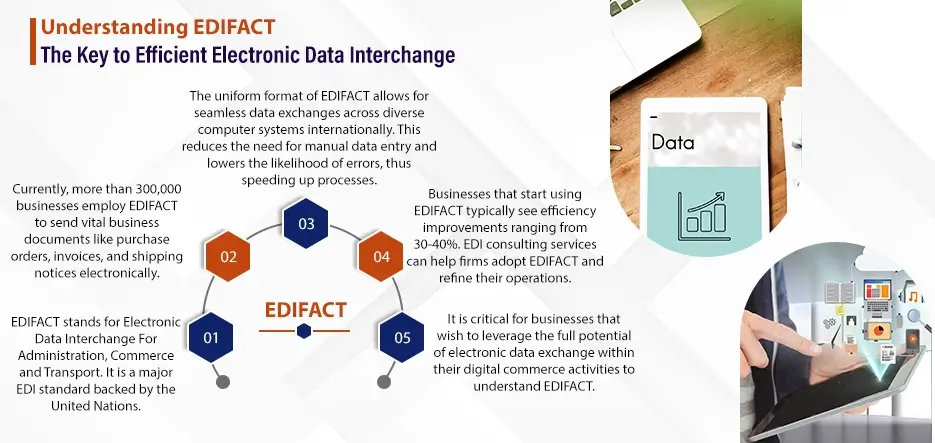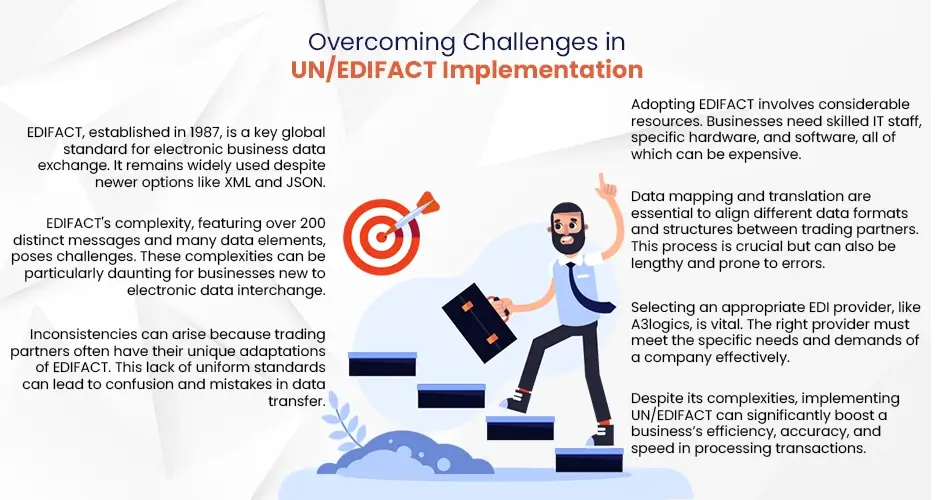Table of Contents
Businesses transmit more than 20 billion EDI transactions annually. Electronic data interchange (EDI) is crucial to efficient commerce and supply chain management. EDIFACT, formulated by the United Nations, allows companies around the world to exchange business documents electronically in any generic XML-specific form, regardless of the application. More than 300,000 companies are using EDIFACT. These invoices are your payment orders, invoices, shipping notes, and other business documents. Its syntax and structure in EDIFACT are so distinct that the solution allows data to flow seamlessly across various computer systems, even those widely scattered through different countries. This eliminates manual data entry, reduces errors, and speeds up processing. On average, companies using EDIFACT experience a 30-40% increase in efficiency. Companies can obtain assistance with implementing EDIFACT and improve their process through EDI consulting services.
In this blog post, we’ll get behind the scenes on the EDIFACT standard. This post will discuss how EDIFACT works, its advantages, and some common practices. Whether you are new to EDI or would like to enhance your existing processes, EDIFACT is important. It can also unlock the full potential of electronic data interchange for your business. Read on to find out more about this fundamental digital commerce tool. Whether you are new to EDI services or looking to improve them, we have you covered.

What is UN/EDIFACT Syntax?
The standard format of EDI (Electronic data interchange) messages is referred to as UN/EDIFACT Syntax. The Full Form of EDIFACT is Electronic Data Interchange for Administration, Commerce & Transport. It is the universal protocol used for EDI. This is implemented by the United Nations Economic Commission for Europe (UNECE).
Syntax Elements in EDIFACT help ensure a standard way of EDI messages. It makes it more convenient for companies to share information electronically. The syntax describes EDI messages. It includes segments, data elements, and groups that compose the message.
EDI service providers play an essential role in the facilitation of using EDIFACT syntax. They provide a variety of services. This includes EDI mapping, translation, and integration to assist businesses in sharing information electronically. They also offer tools and resources that help companies adhere to EDIFACT guidelines. They make sure that EDI messages are correct and free of errors.
Importance It Brings On The Table
One of the main advantages of the use of EDIFACT syntax is the ability for businesses to exchange data efficiently. All this without the necessity of manually entering data as well as paper-based records. This will ensure businesses become more efficient, reduce costs, and offer better customer service.
Using EDIFACT syntax also is another great asset, as it is accepted internationally. And this is what allows organizations to exchange information via a common language on a worldwide scale. This will increase communication and collaboration between businesses and make it simpler to conduct business globally.
The UN/EDIFACT Syntax is the standard format for electronic data interchange. It is administered by the UNECE. Over the world, many companies, as well as other organizations, have been making use of this tech. The EDI companies play an important role in supporting its usage. The use of EDIFACT syntax can assist companies in enhancing communication, improving efficiency, and lowering cost.
Start Harnessing the Benefits of UN/EDIFACT for Accelerated Business Growth
Understanding the UN/EDIFACT Structure
EDIFACT is the international cross-industry standard for electronic data interchange (EDI) and is used by more than 10,000 companies from a broad range of industries. Using EDIFACT allows companies to obtain a variety of advantages:- increasing efficiency, improving precision, and minimizing costs. The objectives of this paper are to outline some of the advantages of using EDIFACT within businesses and how they contribute towards business goals for improving productivity.
1: The structure of EDIFACT is built on a set of messages used to exchange specific kinds of documents for businesses. Each message consists of segments that are further broken into data components. The segments and data elements are standard and have distinct definitions. This makes it easier for businesses to process and understand the information transmitted.
2: There are several top EDI companies USA that provide EDIFACT compliance and implementation services for businesses. They are experts in EDIFACT structure. It assists businesses in establishing EDI solutions that fit the requirements of their particular business.
3: The usage of EDIFACT provides numerous benefits for companies. This includes improved efficiency and precision in the exchange of documents for business. Since the EDIFACT structure is standard, companies can exchange data more quickly and efficiently. It decreases the requirement to manually enter data and eliminates mistakes.
4: The use of EDIFACT can assist businesses in enhancing the management of their supply chains. All this by offering immediate visibility into the status of orders, inventory levels, and shipment tracking. This helps businesses make better-informed choices and respond faster to fluctuations in demand or disruptions to the supply chain.
5: Another advantage that comes with EDIFACT is that it’s an international standard. This makes it much easier for companies to collaborate with customers and partners in different countries. Since it is a structure in which EDIFACT is standardized, businesses can exchange information from different countries. All this without needing expensive and lengthy transformations or translations.
So, knowing the EDIFACT structure is crucial for companies looking to use EDI solutions. It enhances the management of their supply chains. Through working with the leading EDI businesses in the USA, firms can be assured that they’re making use of the EDIFACT effectively.
The advantages of implementing UN/EDIFACT
EDIFACT is the international cross-industry standard for electronic data interchange (EDI) and is used by more than 10,000 companies from a broad range of industries. Using EDIFACT allows companies to obtain a variety of advantages:- increasing efficiency, improving precision, and minimizing costs. The objectives of this paper are to outline some of the advantages of using EDIFACT within businesses and how they contribute towards business goals for improving productivity.
1: Firstly, it offers a specific format to interchange business documents electronically, such as invoices, purchase orders, and shipping notifications. The standardized nature of the format means that they should not have to input data manually from a myriad of formats, and should be beyond those errors arising from documents in many forms going over error-prone faxing. EDIFACT enables businesses to manage data exchanges better, accelerating overall operating efficiency through minimal processing time and effort.
2: EDIFACT can provide a way for a firm to communicate rich data when it securely comes to different trading partners. Businesses can encrypt their data for secure transmission via the Internet with EDIFACT. This will not only help in safeguarding the critical info but also in making sure that the data coming in and going out is correct.
3: Additionally, using EDIFACT may help businesses significantly reduce their costs. More importantly, companies can also facilitate automation of the data exchange process and save time and money because they will not need to enter everything manually. Using EDIFACT also allows businesses to save costs on errors such as sending documents in multiple different formats, which can then lead to fines, chargebacks, and revenue loss.
4: EDIFACT allows for more flexibility in the exchange of data between businesses. EDIFACT enables the business to share data with its trading partners at a time when the data is reasonable, allowing the business to react quickly to changes in the market. Real-time data exchange enables businesses to optimize their inventories – cutting costs and keeping customers happy.
5: When companies are using EDIFACT then, they can improve their customer service. By making the data exchange more automated, businesses can also react faster and more accurately to the demands of their customers, even further boosting customer loyalty and satisfaction by extension. Finally, EDIFACT means companies can provide increased depth and speed of such information to their customers about their orders and enhance overall customer satisfaction.
6: EDIFACT is an essential tool for international business. For international communication, regardless of country, time, and even different currencies and languages, EDIFACT is used by companies to pass data between them and their trading partners. This will help businesses in growing their business and expanding to new segments which are going to increase revenue and profit.
7: The use of EDIFACT will enable businesses to stay relevant to protect their turf in a cut-throat world of business. By automating data exchanges and thus facilitating their operations, companies can reduce costs and improve their ability to adapt to market contractions. This will enable companies to cut down on competitive aspects and to keep ahead of the pack.
Therefore, businesses can benefit from implementing EDIFACT to become more efficient and precise and operate at a lower cost. This means that EDIFACT allows companies to simplify their data exchange process, improve their customer service, and expand their businesses to virtually anywhere in the world. Secondly, EDIFACT streamlines businesses to keep them in the game in the contested business environment that it is today. If you decide to use EDIFACT, working with EDI solution providers is key because they will help you build a tailored solution that fits your particular business needs.
Ways in which UN/EDIFACT affects different industries
EDIFACT means Electronic Data Interchange for Administration, Commerce, and Transport. It is a global standard for exchanging corporate papers. EDIFACT is a system that is used by various computer systems to easily transfer and exchange data, making it easier for businesses to share records and exchange papers among themselves. One might be curious about how UN/EDIFACT has influenced various industries. Following are some of the industries that use EDIFACT and how EDIFACT has influenced them.
Logistics
The logistics industry has broadly benefitted from UN/EDIFACT in recent years. It is accessible to logistics providers who could give them information on their shipment, their delivery schedule, and possibly their invoice. Information regarding clients’ shipments has helped logistics providers easily monitor all their deliveries to ensure that every client gets the goods within the expected period after an exchange has been applied. Furthermore, UN/EDIFACT has helped logistics providers save money by communicating manually and using paper since they have been able to use their press altogether.
Healthcare
Another field that has benefitted from UN/EDIFACT is health care. UN/EDIFACT allows healthcare providers to exchange patients’ information on their previous medical history and prescriptions. Healthcare providers would know how to collaborate more by enabling them to appropriate supervision of their various clients. UN/EDIFACT involves mistakes and supports guaranteeing that people shift their correct statements on different schemes.
Automobile
The automotive industry has also gained a lot from EDIFACT. The EDIFACT system allowed automobile manufacturers to analyze production information on demand and exchange orders, parts, and shipment information with dealers and suppliers. This is assuaging for businesses as well, who have a better grip on their supply chains. So they have all of that good on time. Automotive manufacturers, in turn, were able to save pennies in their procurement procedures thanks to EDIFACT.
Retail
The retail industry was also a big beneficiary of EDIFACT. Retailers can exchange data on orders, shipments, and invoices with their suppliers or suppliers making it easier for them to monitor their stock and make sure they have the best product in the right place at the right time. Automation is going to take over all purchasing processes and being free of error will also avoid many costs to the retail market.
Also, the adoption of EDIFACT in various industries was facilitated by EDI providers. Although they provide software and services that help companies leverage EDIFACT and different EDI standards. They provide help and training to businesses to help them improve the effectiveness of the EDI processes of businesses and ensure that they are getting out the most from their EDI investment.
In simple words, EDIFACT has changed the way of work in various sectors by enabling secure and verifiable data exchange. It simplifies the process of information sharing between industries and has resulted in increased cooperation, reduced costs, and increased efficiency. Using EDIFACT allows companies to eliminate errors and deliver a better service to clients. This is achieved by the following means: Accurate data exchange between multiple systems. Top EDI providers are key contributors to the evolution of EDIFACT. Companies are given the support and tools to implement EDIFACT in addition to different EDI standards.
Problems Encountered During The UN/EDIFACT Implementation
EDIFACT is a worldwide standard that enables the electronic data interchange of both Business-to-business (B2B) and business processes. It has been there since 1987. It’s still helping s despite the arrival of contemporary technologies like XML and JSON. It is not a straightforward process for businesses (they need to know about electronic data interchange) – especially businesses that are trying to use electronic data interchange for the first time. Here we have articulated the problems that come with UN/EDIFACT implementation in the article below.ACT implementation in the article below.

- UN/EDIFACT standards are very complex. They include more than 200 different messages and lots of details. This makes it hard for companies to use them without previous experience in data exchange.
- There’s also an issue with standardization. Although it is a global standard, different partners may have their versions and understandings. This can lead to mistakes and confusion during data exchanges, especially if they are using different versions.
- Furthermore, using EDIFACT needs a lot of technical skills and resources. Companies need IT experts who know UN/EDIFACT well. They also have to buy special equipment and software to handle EDIFACT transactions. This can be expensive.
- Mapping and translating data is another big task. Since each partner might use different data formats, a company has to adjust its data to fit the EDIFACT standard and then again for each partner’s format. This takes a lot of time and can easily lead to mistakes, especially with many partners involved.
- Mapping and translating data is another big task. Since each partner might use different data formats, a company has to adjust its data to fit the EDIFACT standard and then again for each partner’s format. This takes a lot of time and can easily lead to mistakes, especially with many partners involved.
Despite these issues, using UN/EDIFACT can bring many benefits like better efficiency, more accuracy, and quicker processing. With the help of EDI consultants, businesses can efficiently implement EDIFACT and detail their data exchange processes to the highest potential.
The Future of EDIFACT: Trends and Innovations
Blockchain Revolution
Blockchain creates a safe, open record of transactions. This can make EDI more secure and clear. It may also lower costs by reducing the need for middlemen and speeding up data exchanges.
Artificial Intelligence (AI) Takes Center Stage
AI can make it easier to map and translate data between formats. This helps UN/EDIFACT work faster and with fewer errors. AI can also offer insights from EDI data, helping businesses understand more.
Internet of Things (IoT) Integration
The IoT connects devices to the internet. Using IoT with EDIFACT can allow real-time data sharing. This might make managing supply chains and stock more efficient.
APIs and Cloud-Based Solutions
APIs let different software systems talk to each other. Cloud-based EDI systems are easier to use and grow. Using APIs with cloud tech can make UN/EDIFACT solutions more adaptable and easy to access.
Embracing Global Standards
As global trade increases, so does the need for standard EDI rules. The UN/CEFACT is making these rules to help with international data swaps. Using these rules can make dealing with data across countries simpler.
By keeping up with these trends, businesses can improve their EDIFACT strategies. Working with experienced EDI services, like A3Logics, helps companies stay ahead and benefit from these developments.
EDIFACT Implementation Best Practices: Tips for a Smooth Transition
Implementing EDIFACT can seem daunting, but with the right approach, you can ensure a smooth transition. Here are some best practices and tips to keep in mind:
Partner with EDI Experts
- Work with experienced EDI consulting company, like A3Logics
- They can guide you through the implementation process and provide valuable insights
- EDI experts can help you avoid common pitfalls and ensure your implementation stays on track
Assess Your Current Systems
- Take stock of your existing IT infrastructure and business processes
- Identify areas where EDIFACT can provide the most benefit
- Determine if any systems or processes need to be updated or replaced to support EDIFACT
Define Your Requirements
- Clearly define your business needs and goals for implementing EDIFACT
- Involve key stakeholders from different departments to ensure all requirements are considered
- Prioritize your requirements based on their impact and feasibility
Train Your Staff
- Provide comprehensive training for all staff members who will be using EDIFACT
- Ensure they understand how EDIFACT works and how it will impact their day-to-day tasks
- Offer ongoing support and resources to help staff adapt to the new system
Test, Test, Test
- Thoroughly test your EDIFACT implementation before going live
- Conduct end-to-end testing to ensure data is being exchanged accurately and efficiently
- Involve key trading partners in the testing process to verify compatibility
Monitor and Optimize
- Continuously monitor your EDIFACT implementation to identify any issues or areas for improvement
- Collect feedback from staff and trading partners to gauge the effectiveness of your implementation
- Make adjustments as needed to optimize performance and ensure ongoing success
Final Thoughts
EDIFACT has changed how global business trade works. This system makes it easier to share data electronically, improving efficiency and accuracy and reducing costs. Despite new technology, EDIFACT remains key for smooth communication between trading partners.
Starting with EDIFACT can be tough for those new to EDI. It’s important to really know its standards and messages and manage data across different formats well. Also, businesses often struggle because trading partners have different standards, which requires a lot of technical skills and resources.
To deal with these challenges and get the most from EDIFACT, many companies get help from professional EDI consulting services. These experts help with picking the right tools and testing data flows. Partnering with experienced EDI consultants ensures a smoother start with EDIFACT and helps avoid common problems.
The future for EDIFACT looks bright. Everything points to more companies digitally transforming and working harder on their supply chain, so there is an increasing demand for robust and trustworthy EDI solutions. To succeed in the evolving global trade landscape, companies should stay current with EDIFACT changes and leverage trustworthy third-party vendors.
Thinking of enhancing your business with EDIFACT? Consider working with A3Logics





